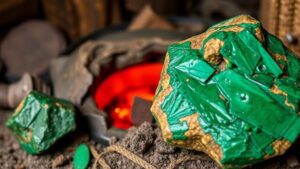Spotting Geologic Features That Act as Natural Ore Concentrators
Spotting Geologic Features That Act as Natural Ore Concentrators
The intricate processes of geologic formations have led to the development of natural ore concentrations, which play a crucial role in mineral extraction and resource management. Understanding the geologic features that facilitate these concentrations is essential for geologists, miners, and environmental scientists alike. This article delves into the various geologic formations that act as natural ore concentrators, highlighting their characteristics, examples, and their implications for resource extraction.
The Mechanisms of Natural Ore Concentration
Natural ore concentrators function through several geological phenomena that enhance the concentration of economically valuable minerals in specific areas. primary mechanisms include:
- Weathering: The decomposition of rocks can liberate minerals, which are then transported by wind or water.
- Hydrothermal Processes: Hot fluids can concentrate minerals as they move through rock formations, depositing them in veins.
- Gravitational Settling: Heavy minerals may settle in particular locations due to gravitational forces, leading to high concentrations.
Geologic Features Acting as Ore Concentrators
Several key geologic features serve as natural ore concentrators. Below, we explore some of the most significant types:
1. Faults and Fractures
Faults and fractures in the Earths crust create pathways for mineral-bearing fluids. e areas may become enriched with minerals over time as hydrothermal solutions flow through and deposit ore minerals.
A prime example is the fault-controlled gold formations in the Carlin Trend of Nevada, which hosts some of the worlds richest gold deposits. The interplay between faulting and mineralization illustrates how these geologic features can create substantial ore concentrations.
2. Sedimentary Basins
Sedimentary basins accumulate vast amounts of sediment over time, and this process can serve as a natural concentrator for various minerals. layering and compaction of sediments often lead to increased mineral abundance.
The Gulf of Mexicos sedimentary basin, for instance, contains significant reserves of petroleum and natural gas. The organic materials deposited in these basins eventually transform into hydrocarbons, showcasing how sedimentary processes can concentrate valuable resources.
3. Igneous Intrusions
Igneous intrusions, such as batholiths and dikes, often lead to the formation of metallic ores as magma cools and crystallizes. As the magma rises, it can introduce mineral-rich fluids into surrounding rocks, creating deposits.
The Norilsk-Talnakh region in Russia is renowned for its nickel, copper, and platinum deposits resulting from extensive igneous intrusions. Here, the interaction between the magma and country rocks has generated significant mineral concentrations.
Impact of Natural Ore Concentrators on Mining
The discovery and exploitation of natural ore concentrations have profound implications for the mining industry. Recognizing these geologic features can lead to more efficient exploration and extraction methods, ultimately conserving resources and reducing environmental impact.
- Efficient Resource Identification: Understanding the geological context allows for targeted exploration, minimizing resource wastage.
- Reduced Environmental Footprint: More effective mining practices lead to less disruption and habitat destruction during resource extraction.
For example, in areas where hydrothermal processes dominate, miners can focus on extracting from veins or pods rather than blanket areas, allowing for a more sustainable approach.
Future Directions in Research and Exploration
Exploration for natural ore concentrators is an evolving field, with technological advancements shifting the paradigm towards more accurate modeling and simulation. Geophysical methods, satellite imagery, and advanced mining technologies integrated into exploration strategies, promising a new era of efficient mineral extraction.
Continued research into the geologic features that act as natural ore concentrators will play a pivotal role in meeting future resource demands while ensuring environmental stewardship.
Conclusion
Spotting geologic features that concentrate ores is critical for efficient resource extraction and environmental preservation. By understanding mechanisms such as fault systems, sedimentary processes, and igneous intrusions, professionals in the field can refine their exploration strategies and minimize the ecological impact of mining. Moving forward, a commitment to integrating advanced technologies into the exploration process will be essential in sustainably harnessing these natural resources.


